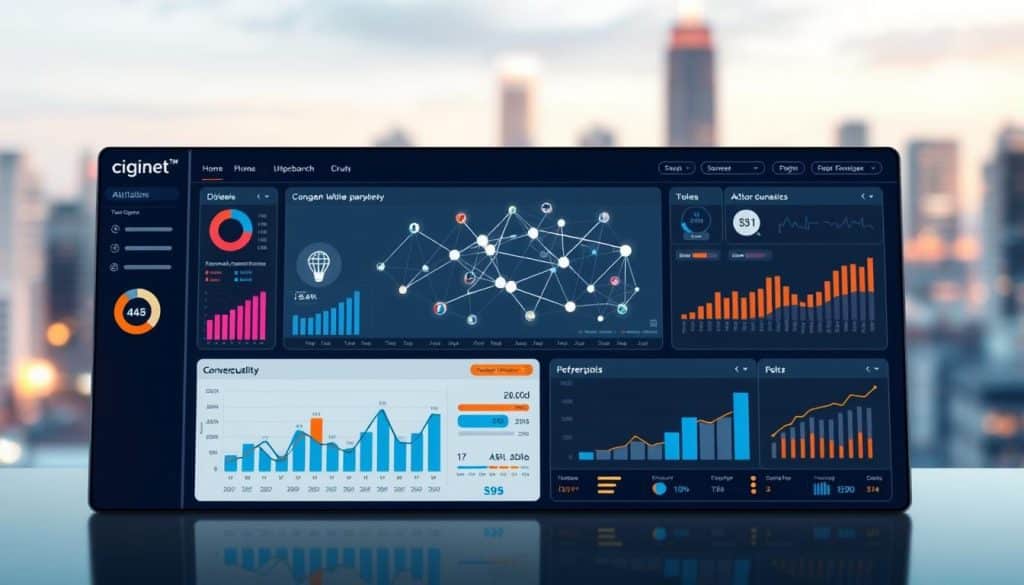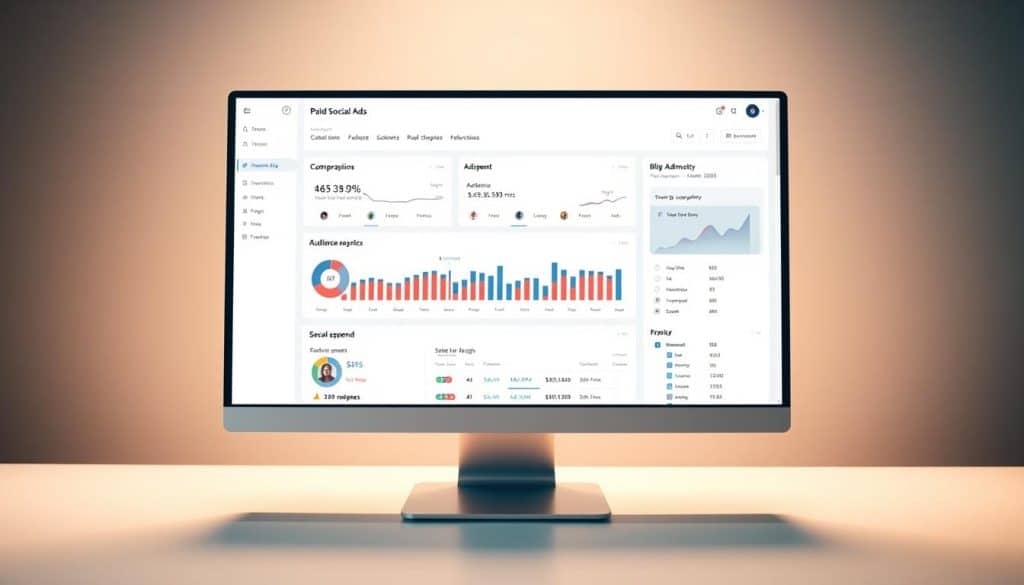Marketing automation has transformed digital strategies, helping businesses reach their goals faster. 91% of marketers say automation aids in achieving objectives. Let’s explore ways to boost your automation game.
Automated emails generate 31% of all email orders. Marketers using automation tools are 46% more likely to report effective strategies. These stats highlight the power of mastering automation techniques.

We’ll uncover expert strategies to help you excel in marketing automation. You’ll learn how to set clear goals and create engaging content.
We’ll also show you how to use A/B testing effectively. These insights will help you grow your business right away.
Key Takeaways
- Marketing automation boosts goal achievement
- Automated emails drive significant orders
- Clear objectives are crucial for success
- Engaging content is key in automation
- A/B testing optimizes automation efforts
- Actionable insights lead to business growth
Streamline your marketing processes with AI-powered automation. Save time & grow faster today!Marketing Automation (Powered by AI Arkitechs)
Automate, Scale, and Win!
Understanding Marketing Automation Fundamentals
Marketing automation has transformed business approaches to customer engagement. This technology streamlines processes, boosting productivity and saving time. Employees believe they could save 240 hours yearly through automation.
Defining Marketing Automation and Its Core Benefits
Marketing automation uses software to automate repetitive tasks, enhancing customer experiences. It drives conversions, with 77% of users reporting increased success.
Key benefits include streamlined marketing efforts and improved customer experiences. It also minimizes manual tasks, freeing up time for strategic work.
The Evolution of Marketing Automation Technology
Marketing automation has evolved from basic email systems to sophisticated AI-driven platforms. Today’s tools offer integrated cross-channel strategies, ensuring cohesive user experiences.
This progress has led to widespread adoption. Now, 71% of B2B marketers primarily use automation for email marketing.

Key Components of Marketing Automation Systems
Modern marketing automation systems include several crucial elements. These are lead capture tools, email platforms, CRM integration, analytics, and automated lead scoring.
- Lead capture tools
- Email marketing platforms
- CRM integration
- Analytics capabilities
- Automated lead scoring
These components create a powerful ecosystem for managing marketing efforts. For example, automated lead scoring prioritizes high-value prospects, boosting conversion rates.
| Component | Function | Benefit |
|---|---|---|
| Lead Capture Tools | Collect customer information | Increase lead generation |
| Email Marketing Platforms | Automate email campaigns | Improve customer engagement |
| CRM Integration | Centralize customer data | Enhance customer insights |
| Analytics Capabilities | Track campaign performance | Optimize marketing strategies |
| Automated Lead Scoring | Prioritize high-value prospects | Boost conversion rates |
By using these components, businesses can unleash the full potential of marketing automation. This drives growth and strengthens customer relationships, leading to long-term success.
A Marketing Automation Platform streamlines repetitive tasks like email campaigns, lead nurturing, and social media management, allowing businesses to save time and boost efficiency. With tools like AI Arkitechs, you can automate processes, deliver personalized experiences, and drive better results—all while focusing on growing your business.
Setting Strategic Goals and KPIs
Strategic planning is crucial for marketing automation success. We set clear objectives and key performance indicators (KPIs) to drive growth. This ensures our automation efforts align with company goals.
Identifying Business Objectives
We start by pinpointing specific business aims. These may include boosting lead generation or improving conversion rates. A company might target a 20% monthly increase in leads.
Another goal could be doubling their average customer value. Clear objectives guide our automation strategies effectively.
Establishing Measurable Success Metrics
After setting objectives, we define measurable KPIs. These metrics track progress and show return on investment. Common KPIs include email open rates and click-through rates.
Segmented campaigns often perform better. They yield 14.31% higher open rates and 9.37% lower unsubscribe rates.
Aligning Automation Goals with Business Growth
We sync marketing automation goals with business growth strategies. This creates a unified approach for driving results. Many companies plan to use AI for content creation. As a personal advice, this is a very powerful opportunity if you use it correctly
In fact, 76% aim to use generative AI for copywriting. This can boost efficiency and output, streamlining marketing processes.
Email Marketing Automation simplifies and enhances the way businesses engage with their audience. By automating tasks like welcome emails, follow-ups, and personalized campaigns, it ensures timely and relevant communication. Platforms like AI Arkitechs make it easy to nurture leads, boost conversions, and maintain strong customer relationships with minimal effort.
The right automation strategy improves efficiency and increases revenue. It also enhances customer engagement. Platforms like HubSpot help create targeted campaigns.
Today, 71% of consumers expect personalized interactions. Automation is key to meeting these expectations and driving growth.
Creating Effective Customer Journey Maps
Customer journey mapping is vital in marketing automation. It helps businesses improve customer engagement throughout the buying process. Recent studies show 88% of customers value their experience with a company as much as its products.
Data-driven marketing leverages insights from customer behavior, preferences, and interactions to create more targeted and effective campaigns. By analyzing data, businesses can make informed decisions, personalize their strategies, and optimize performance, ensuring better engagement, higher ROI, and sustained growth.
Effective journey maps plot strategic checkpoints, guiding leads towards conversion. They reveal insights into customer behaviors, preferences, and pain points across various touchpoints. Businesses can use these insights to tailor their marketing efforts at each stage.
Well-executed customer journey mapping has a significant impact. Businesses automating the customer journey can see a 451% increase in qualified leads. Connecting multiple touchpoints through automation can boost customer satisfaction by 20% and cut operational costs by 40%.
To create effective journey maps:
- Identify key touchpoints across online and offline channels
- Analyze customer behavior at each stage
- Use data analytics to understand user actions and preferences
- Incorporate emotional factors influencing purchase decisions
- Tailor marketing strategies based on customer insights
Most consumers (73%) expect brands to understand their needs and preferences. Effective journey mapping helps businesses meet these expectations. This approach enhances customer satisfaction and builds brand loyalty in a competitive market.
Best Practices for Managing Marketing Automation Tools
Marketing automation tools are vital for business growth. The right platform and strategies can revolutionize your marketing efforts.
Selecting the Right Automation Platform
Choose a platform that fits your business needs. Look for scalability, integration capabilities, and user-friendly interfaces. Successful companies have a well-defined lead management flow.
Integration and Implementation Strategies
Smooth integration with existing systems is crucial. Focus on thorough staff training for easy adoption. Companies prioritize better reporting, lead scoring, and routing for alignment.
Implementing marketing automation can be tricky. 61% of companies find the process challenging.
Tool Optimization and Maintenance
Regular updates and data cleansing boost performance. Monitor your tools to refine strategies and make adjustments. Personalize content for audience segments to improve engagement.
- Build dynamic nurture programs
- Collect data through lead capture forms
- Segment lists based on shared qualities
These practices ensure your automation tools deliver maximum value. Marketing automation can boost qualified leads by 451% and cut sales cycles in half.
It can also increase newsletter and sales mailing open rates by 173%.
Lead Scoring and Nurturing Strategies
Lead scoring and nurturing are vital for effective marketing automation. These methods help businesses find and grow potential customers. They boost conversion rates and increase revenue.
Developing a Lead Scoring Framework
A strong lead scoring system gives points to lead behaviors and traits. It helps focus on leads most likely to convert. This saves time and resources.
Companies using lead scoring see a 53% rise in conversions. They also cut time wasted on poor leads by up to 50%.
Creating Automated Nurture Campaigns
Automated nurturing guides prospects through the sales funnel. These campaigns build trust by answering questions. They also boost engagement.
Mature lead practices help achieve 9.3% higher sales quotas. Great lead nurturing creates 50% more sales-ready leads.
Personalizing Lead Communication
Personalization is crucial in lead communication. Tailored messages greatly increase engagement and conversions. Relevant nurture emails generate 18 times more revenue than broadcast emails.
Lead scoring helps segment contact lists. This enables targeted marketing campaigns. It enhances overall effectiveness.
Integrating automated lead scoring with CRM systems updates lead data in real-time. It ensures quick sales team responses. This approach optimizes marketing ROI and frees teams for strategic tasks.
Set clear goals and regularly check conversion rates. This helps refine lead scoring and nurturing strategies. It leads to optimal results.
Content Strategy for Automated Campaigns
A strong content strategy is key for successful automated campaigns. It helps create engaging content that connects with your audience. Marketing automation streamlines processes, offering personalized experiences to target audiences.
Research shows that 47% of marketers succeed by understanding their audience. A diverse content mix is crucial. This includes blog posts, quizzes, guides, and webinars.
Aligning content with the customer journey is important. It ensures each piece moves leads through the funnel effectively.
Automated campaigns deliver personalized content, boosting engagement and conversions. In fact, 80% of shoppers prefer companies offering personalized experiences. Valuable content helps businesses become trusted industry authorities.
Segmentation is vital in content strategy for automated campaigns. It involves dividing customer lists based on demographics and behavior. This approach improves campaign effectiveness significantly.
Behavior-based triggers create timely, personalized interactions. These align with users’ interests and needs.
To boost your content strategy’s impact, consider these key points:
- Use A/B testing to compare different content versions.
- Use automation tools to understand audience behavior and content performance.
- Monitor key performance indicators to refine your automation strategies.
These practices can lead to impressive results. 80% of marketing automation users saw more leads. 77% reported higher conversions.
Companies using marketing automation have seen productivity gains up to 20%. Mastering content automation needs strategy and ongoing improvement.
With the right approach, automated campaigns can boost engagement. They nurture customer relationships and drive long-term business growth.
Data Analytics and Performance Optimization
Data analytics and performance optimization are crucial for successful marketing automation. These practices help businesses track efforts and make smart decisions. Marketing automation software boosts efficiency and improves customer experiences by streamlining tasks.
Tracking Key Metrics and ROI
Effective marketing automation needs constant tracking of performance metrics. This helps businesses measure strategy effectiveness and make data-driven choices.
Key metrics often include email open rates, click-through rates, and conversion rates. Return on investment (ROI) is also an important metric to track.
A/B Testing Methodologies
A/B testing is vital for performance optimization. It compares two versions of a marketing element to find the better performer.
Common A/B tests include email subject lines and landing page layouts. Call-to-action buttons are also frequently tested.
| Element | Version A | Version B |
|---|---|---|
| Email Subject | “Limited Time Offer” | “Exclusive Deal Inside” |
| CTA Button | “Buy Now” | “Get Your Deal” |
| Landing Page Layout | Single Column | Two Columns |
Continuous Improvement Processes
Marketing analytics automation simplifies data tasks. It uses techniques like predictive modeling and segmentation analysis. Businesses can tailor messages using audience segmentation based on demographics and interests.
To get the most from marketing analytics automation, align with business goals. Ensure clean data, choose the right tools, and foster a data-driven culture.
This ongoing approach keeps marketing strategies effective in the changing digital world. It allows for quick adjustments and improvements based on real-time data.
Conclusion
Marketing automation best practices have transformed digital marketing. These strategies boost engagement and increase conversions. Automation can cut sales cycles by 50% and boost productivity by 20%.
Automation saves time and resources while achieving results. It lets marketers focus on lead nurturing and email marketing. This efficiency can increase revenue per customer and brand loyalty.
Creating compelling content is key to harnessing automation benefits. Mapping the customer journey and setting clear goals are also crucial. Tools like SureTriggers offer all-in-one solutions to streamline workflows.
Tracking metrics and analyzing customer behavior are essential. Refining campaigns based on data insights improves strategies. This approach leads to sustainable success in the digital marketplace.
FAQ
What is marketing automation and why is it important?
Marketing automation uses software to streamline repetitive tasks and boost customer engagement. It saves time, improves lead nurturing, and increases conversions. Many marketers credit automation for helping them reach their goals.
How do I set effective goals for my marketing automation strategy?
Start by identifying specific business objectives, like increasing leads or boosting conversion rates. Set measurable success metrics that align with your growth strategies. Documenting these strategies greatly improves the chances of marketing success.
What should I consider when choosing a marketing automation platform?
Look for scalability, integration capabilities, and alignment with your business needs. Choose tools that connect with your existing systems and offer staff training. Factor in ongoing optimization and maintenance needs too.
How can I effectively score and nurture leads using marketing automation?
Create a lead scoring system that assigns values to different behaviors and attributes. Set up automated campaigns to guide leads through the sales funnel. Personalize your messaging to increase engagement and conversion rates.
What role does content play in marketing automation?
Content is crucial for successful automated campaigns. Create engaging material that addresses your audience’s needs and offers solutions. Mix up content types like blog posts, quizzes, and webinars for different customer journey stages.
How can I optimize the performance of my marketing automation efforts?
Track key metrics and ROI to understand campaign effectiveness. Use A/B testing to refine various elements of your marketing campaigns. Regularly analyze results and make data-driven improvements.
How does marketing automation impact customer engagement?
Automation allows for personalized, timely interactions across multiple channels. It helps create seamless experiences that drive engagement and build loyalty. This approach often leads to higher conversion rates.
What are some key components of modern marketing automation systems?
Modern systems include lead capture tools, email marketing platforms, and CRM integration. They also feature analytics capabilities. These elements work together to manage and optimize marketing efforts across channels.






